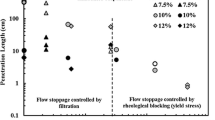Abstract
Permeation grouting is a ground improvement method commonly used for strengthening and/or reducing permeability of soils with minimal disturbance to the existing soil structure. Cement/microfine cement grouts are the most common form of grouts used for sandy soils; however, the effectiveness and uniformity of the grout propagation is often hindered by filtration of cement particles during flow. Finding the right balance of low viscosity and high internal stability of grout mixes is site specific and can be the difference between a successful ground improvement application or not. However, the current methods used for measuring grout stability are based on index tests and might not always reflect the grout performance in the field, particularly with all the recent advancement in manufacturing finer grained cements and super plasticizers. This paper presents a combination of three digital imaging-based experimentations to help provide a better “inside-look” into grout stability and permeation. First, image analysis on bleed testing is used to reveal the internal stability of grouts by evaluating the w:c ratio along the height of the grout column rather than simply measuring the clear water bleed at the top. Second, a 2-D grout permeation testing is utilized to show the difference in grout-front propagation over time for stable versus unstable grouts, relative to the expected theoretical front. Last, stable and unstable grouts are permeated through transparent soil columns to provide a true “inside-look” of what deep-bed filtration looks like. This last visualization of deep-bed filtration is a direct look into the filtration process as it develops, something not commonly seen, although often predicted from post-permeation decrease in strength as we move away from the injection source. The outcome of these three complementary methods allow for a holistic understanding of internal grout stability and its impact on uniformity of grout delivery into sands.














Similar content being viewed by others
Data Availability
Enquiries about data availability should be directed to the authors.
References
ASTM D2487 (2017) Standard practice for classification of soils for engineering purposes (unified soil classification system). American Society for Testing Materials International Book of Standards 04.08. https://doi.org/10.1520/D2487-17
ASTM D6913 (2017) Standard test methods for particle-size distribution (gradation) of soils using sieve analysis. American Society for Testing Materials International Book of Standards 04.09. https://doi.org/10.1520/D6913_D6913M-17
ASTM C1874 (2020) Standard test method for measuring rheological properties of cementitious materials using coaxial rotational rheometer. American Society for Testing Materials International Book of Standards 04.01. https://doi.org/10.1520/C1874-20
Axelsson M, Gustafson G, Fransson Å (2009) Stop mechanism for cementitious grouts at different water-to-cement ratios. Tunn Undergr Space Technol 24(4):390–397
El Mohtar CS, Bobet A, Santagata MC, Drnevich VP, Johnston CT (2012) Liquefaction mitigation using bentonite suspensions. ASCE J Geotechn Geoenviron Eng 139(8):1369–1380
El Mohtar CS, Yoon J, Sangroya R, Jaffal H (2017) Transferring innovative research into practical wisdom: the case of permeation grouting. Innov Infrastruct Solut. https://doi.org/10.1007/s41062-017-0093-4
Hashimoto K, Nishihara S, Oji S, Kanazawa T, Nishie S, Seko I, Hyodo T, Tsukamoto Y (2016) Field testing of permeation grouting using microfine cement. Proc Inst Civ Eng Ground Improv 169(2):134–142
Jaffal H, Sangroya R, El Mohtar CS (2017) A laboratory investigation into time-pressure curves for stable versus unstable grouts. In: Proceedings of the grouting 2017: jet grouting deep mixing and diaphragm walls conference, Honolulu, Hawaii, GSP 288 pp.290–300.
Miller AK (2018) Towards better characterization and understanding of internal stability of ultrafine grouts (Masters Thesis). The University of Texas at Austin
El Mohtar CS, Miller AK, Jaffal HA (2017a) Introducing a new method for measuring internal stability of microfine cement grouts. In: Proceedings of the grouting 2017a: Jet grouting deep mixing and diaphragm walls conference, GSP 288, pp.152–162
Mollamahmutoğlu M, Avci E (2015) Effectiveness of microfine portland cement grouting on the strength and permeability of medium to fine sands. Period Polytech Civ Eng 59(3):319–326
Pantazopoulos IA, Markou IN, Christodoulou DN (2012) Development of microfine cement grouts by pulverizing ordinary cements. Cem Concr Compos 34(5):593–603
Warner J (2004) Practical Handbook of Grouting. John Wiley & Sons, NJ, USA
Funding
This work was supported by the National Science Foundation, Geomechanics and Geomaterials program and Geotechnical engineering program, under Grant No. 1254763. This support is gratefully acknowledged.
Author information
Authors and Affiliations
Corresponding author
Ethics declarations
Conflict of interest
The authors have not disclosed any competing interests.
Additional information
Publisher's Note
Springer Nature remains neutral with regard to jurisdictional claims in published maps and institutional affiliations.
Rights and permissions
Springer Nature or its licensor (e.g. a society or other partner) holds exclusive rights to this article under a publishing agreement with the author(s) or other rightsholder(s); author self-archiving of the accepted manuscript version of this article is solely governed by the terms of such publishing agreement and applicable law.
About this article
Cite this article
El Mohtar, C., Jaffal, H., Miller, A.K. et al. Implementing Digital Imaging for Improved Understanding of Microfine Cement Grout Permeation and Filtration. Geotech Geol Eng 40, 4473–4485 (2022). https://doi.org/10.1007/s10706-022-02164-z
Received:
Accepted:
Published:
Issue Date:
DOI: https://doi.org/10.1007/s10706-022-02164-z




